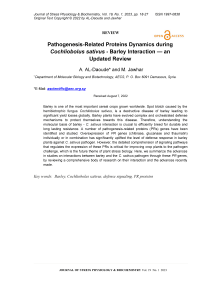Pathogenesis-related proteins dynamics during Cochliobolus sativus - barley interaction - an updated review
Автор: Al-daoude A., Jawhar M.
Журнал: Журнал стресс-физиологии и биохимии @jspb
Статья в выпуске: 1 т.19, 2023 года.
Бесплатный доступ
Barley is one of the most important cereal crops grown worldwide. Spot blotch caused by the hemibiotrophic fungus Cochliobolus sativus , is a destructive disease of barley leading to significant yield losses globally. Barley plants have evolved complex and orchestrated defense mechanisms to protect themselves towards this disease. Therefore, understanding the molecular basis of barley - C. sativus interaction is crucial to efficiently breed for durable and long lasting resistance. A number of pathogenesis-related proteins (PRs) genes have been identified and studied. Overexpression of PR genes (chitinase, glucanase and thaumatin) individually or in combination has significantly uplifted the level of defense response in barley plants against C. sativus pathogen. However, the detailed comprehension of signaling pathways that regulates the expression of these PRs is critical for improving crop plants to the pathogen challenge, which is the future theme of plant stress biology. Here, we summarize the advances in studies on interactions between barley and the C. sativus pathogen through these PR genes, by reviewing a comprehensive body of research on their interaction and the advances recently made
Barley, cochliobolus sativus, defense signaling, pr proteins
Короткий адрес: https://sciup.org/143179376
IDR: 143179376
Текст обзорной статьи Pathogenesis-related proteins dynamics during Cochliobolus sativus - barley interaction - an updated review
Barley ( Hordeum vulgare L.), a member of the grass family Poaceae, is one of the most important crops from an economic point of view, as it is widely used for breweries, animal feeds and human food, and successfully grown under a wide range of environments. According to USDA report, the global barley production in 2021/2022 amounted to about 145.10 million metric tons (USDA 2022). Nevertheless, cereals losses due to fungal diseases continue to pose a huge threat to agricultural food and impact economic decisions as well as practical developments. Using plant genotypes having genetic resistance is considered as an efficient and environmentally suitable approach to alleviate losses caused by the fungal pathogens (Jeger et al., 2021). However, current technologies for molecular genetics of barley resistance towards diseases are based on the over-expression of defense signalling genes in plant (Boccardo et al., 2019; Ali et al., 2022).
Cochliobolus sativus (Ito & Kurib.) Drechsl. ex Dast. [anamorph: Bipolaris sorokiniana (Sacc. in Sorok.) Shoem.], the cause of spot blotch (SB), is an economically important disease of wheat and barley worldwide (Prasad et al., 2013; Rehman et al., 2020; Al-Sadi 2021). The disease is prevalent in North America, Latin America, North Africa, Asia and the Middle East, it causes up to 16%–43% yield losses in warmer areas of the world ( lark 1979; Devi et al., 2018; Kumar et al., 2020). The Syrian SB isolates have shown a diversity of virulence (Arabi and Jawhar 2004; Jawhar et al., 2017a; hen et al., 2022). Therefore, understanding barley- C. sativus interaction at the genetic level is vital for identifying and deploying SB resistance.
Plants are constantly exposed to pathogens and have developed complicated mechanisms to recognize infection and trigger orchestrated defense responses including the generation of reactive oxygen species, the biosynthesis of phytoalexins, cell wall cross-linking, induction of defense enzymes, and the accumulation of pathogenesis-related proteins (PRs) (Juškyt et al., 2022). PRs are a structurally diverse group of proteins induced by plants as a defense response against the attacking fungal pathogens (Antoniw et al., 1980; Alkan et al., 2022). They are known to accumulate in plants post infection by various pathogens as well as upon exposed to certain abiotic stress conditions (van Loon et al., 2006; Boccardo et al., 2019; Ali et al., 2018).
Since the detection of PRs in 1970, 17 PR families have been identified based on amino acid sequences and their biological activities (Kaur et al., 2017; Jo et al., 2020; Anisimova et al., 2021). The majority of these families were identified in tobacco but some others were found in plant species, including monocotyledons such as barley and wheat. The exact functions of different PRs are not completely understood, but they are mainly expressed in plants as glucanases, chitinases and thaumatin-like proteins (GonzÁlez-Teuber et al., 2010; Farrakh et al., 2018; Sharma et al., 2022). Upon pathogen challenge many PRs are located in plant cell gaps and vacuoles which are correspond to their isoelectric points and the contact to stress. Their small size 10–40 kDa leads to the accumulation in intracellular and intercellular spaces (Jo et al., 2020).
This review provides an overview of our current knowledge on the barley- C. sativus interaction, mainly regarding pathogenesis-related proteins alterations. Understanding the molecular basis of this interaction would greatly facilitate the development of new control strategies and the identification of C. sativus and barley factors required for disease progression.
Infection biology
C. sativus survives as conidia on plant wastes in the field as well as on seeds or in the soil as mycelium in infected plant tissues. The infection starts within 4 hr with conidia germinating on the plant leaf, forming an appressorium after 8 hr, and penetrating the cuticle by the hyphae during 12 hr. The fungus spreads into the intercellular space of the mesophyll and its hyphae produce latter conidiophores, which emerge via the stomata carrying new conidia. The new conidial generation is created within 48h that makes the disease highly epidemic with many infection cycles during one growing season (Gupta et al., 2018; Al-Sadi et al., 2021).
C. sativus is well known as a hemibiotroph fungus since it has both biotrophic and necrotrophic phases (Kumar et al., 2002; Shao et al., 2021). It starts as a biotroph and then switched to necrotrophic lifestyle. The biotrophic phase is mostly confined to a single epidermal cell attacked by the infection hypha, whereas the necrotrophic phase begins after infection of the mesophyll tissue followed by host cell death as a consequence of toxin secretion (Apoga et al., 2002; Acharya et al., 2011). Helminthosporol is the major nonspecific toxin produced by C. sativus that affects the permeability of the leaf cell plasma membrane so that the pathogen can nourish of the electrolytes leaked and colonize the host plant tissue (Wisniewska et al., 1998; Apoga et al., 2002). Hence, barley plant has to deploy different defense mechanisms against pathogens with contrasting lifestyles. For this, in depth knowledge on the barley-C. sativus interaction at the genetic level is crucial.
Cell Death during C. sativus Infection
It is documented that the earliest defense responses are opening ion channels through the leaf plasma membranes, induction of active oxygen species such as O 2- and H 2 O 2 , and phosphorylation and dephosphorylation of certain proteins (Doke et al., 1996). These primary reactions are necessary for beginning of the signaling network that further activate the defense responses (Hammond-Kosack and Jones, 1996). Initial H 2 O 2 accumulation in epidermal cell walls under host control may restrict fungal access, whereas high H 2 O 2 accumulation in mesophyll tissue during the second stage results in a massive tissue collapse and fungal colonization. Kumar et al. (2002) and Al-Daoude et al. (2013; 2018) reported that H 2 O 2 may play a dual role in the barley– C. sativus interaction. They reported that 24 and 48 hours post inoculation, H 2 O 2 accumulation was detected in epidermal and mesophyll cells which were completely stained with 3,3-diaminobenzadine (DAB), indicating a hypersensitive reaction (HR) (Fig.1).
Defense responses in prepenetrated epidermal cells included cell wall apposition ( WA) formation, HR, or both, and were found to be associated with failures in fungal penetration. After fungus penetration, defense consisted of HR in epidermal cells may stop successful infection, linking invasion and collapse of mesophyll (Hückelhoven, 2007; Rodríguez-Decuadro et al. 2014).
On the other hand, comprehensive sequencing of expressed sequence tags (ESTs) was used to supply a global picture of barley genes differentially expressed during HR of a barley resistant genotype to C. sativus (AL-Daoude et al. 2009; Jawhar et al. 2017b). These methodologies have allowed the classification of genes assumed involved in barley resistance to C. sativus , including signaling, transcription factors, defense, hypersensitive response, phytohormones pathways, oxidative burst and secondary metabolites biosynthesis (Fig. 2).
Barley Signaling Network
Barley responses to C. sativus have been reported to be highly dependent on the balanced interplay between critical phytohormones which may act differently in several pathosystems (Al-Daoude et al., 2022; Yousaf et al., 2022). Some PRs are considered as the signature genes of salicylic acid (SA) and jasmonic acid (JA) pathways in model and many crop plants, in which the biotrophic pathogen activates the SA pathway, whereas the necrotrophic pathogen stimulates the JA pathway (Ali et al., 2017) (Fig 3).
Recently, it has been reported that SA signaling could have an important role in defense mechanisms against C. sativus disease in contrasting with JA signaling, however, both hormones were induced in response to the same isolate of C. sativus in different barley cultivars (Popova et al., 2017; Al-Daoude et al., 2022). In addition, in C. sativus -infected wheat leaves, the SA-regulated genes TaPAL , TaPR1 , and TaPR2 genes were expressed (Zhang, 2021). However, cross talk and synergistic effects between the defense pathways mediated by SA and JA during different pathogenic infections have been proposed (Schenk et al., 2000; Han and Kahmann 2019). Their pathways are linked with enhanced transcription of PRs that are particularly stimulated both around infection sites and systemically (van Loon et al., 2006; Ali et al., 2018). Several researches indicated that expressing SA and JA signature genes or PR genes in plants lead to increase the resistance to different pathogens (Pieterse et al., 2012; Ali et al., 2017; Anisimova et al., 2021; astro-amba et al., 2022).
PRs expression in resistant and susceptible barley genotypes
PRs are relevant elements of the defense response machinery, many with antimicrobial functions, such as, PR2 (β -1, 3-glucanase), PR3 (chitinases) and PR5 (thaumatin-like) (Manandhar et al ., 1999; Farrakh et al., 2018; Sharma et al., 2022). During barley- C. sativus interaction increased expression of PR1, PR2, PR3 and PR5 genes was recorded along with increasing SA and JA levels (Al-Daoude et al., 2019) (Fig 4 and 5).
The PR1 family contains the first discovered PRs, but, no biochemical role is known for any of the PR-1 proteins (van Loon et al., 2006; Mitsuhara et al., 2008; Fang et al., 2019). The PR2 proteins have functions in catalyze hydrolytic cleavage of β -1,3-D-glucosidic linkages in β -1,3-glucans, and it is supposed to operate primarily on glucans of the fungal pathogen cell wall to release oligosaccharides (Mauch and Staehelin 1989; Boccardo et al., 2019, Anisimova et al., 2021). The plant may then recognize these fragments as elicitors that use to activate further defense responses. Both PR-2 and PR-3 are likely to play double functions in plant defense both directly by hydrolyzing structural components from the cell walls of the pathogen and indirectly by releasing elicitors that might intensify the plant defense response (Stintzi et al., 1993; Rebaque et al., 2021). The PR3 proteins hydrolyze β -1, 4-linkages between N- acetylglucosamines of chitin, releasing oligosaccharides from the pathogen cell walls. It has been proposed that the thinning of the fungal cell walls by PR2 exposes the chitin located in the internal parts of the wall, making it available to chitinases to hydrolyze the fungal cell wall and release elicitors (Kombrink and Somssich 1997; Boccardo et al., 2019).
Our works showed differential PR1, PR2, PR3 and PR5 expressions in barley leaves during the early stage of C. sativus infection, before any visible symptoms are apparent in the tissues (Arabi et al., 2015; Al-Daoude et al., 2017). However, necrosis appeared after approximately 36 hours of inoculation. The northern blot analysis revealed a biphasic accumulation of PR1, PR3 and PR5 mRNA in leaves before these visible symptoms (Santén 2007). On the other hand, Alkan et al. (2022) reported that PR3, PR5 and PR10 were strongly increased in the wheat cultivars resistance pathways after C. sativus infection. Moreover, Al-Daoude et al. (2019) demonstrated that transcripts of the PR1, PR2, PR3 and PR5 genes were accumulated earlier in resistant barley leaf tissues upon challenge with either the biotrophic or the necroptrophic pathogen C. sativus . Importantly, some PR genes were related with a multigene resistance which dispels the current belief that similar mechanisms are activated in response to pathogens with different lifestyle infection (Fig 5).
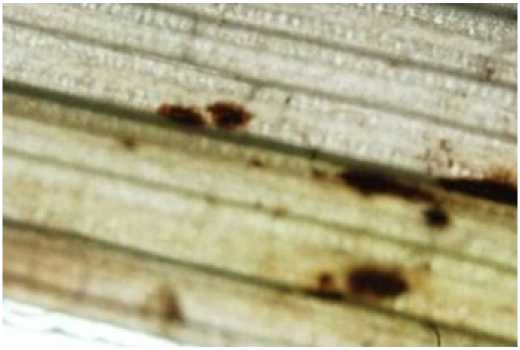
Figure 1. Localization of H 2 O 2 (a) and SB symptoms (b) in tissues of susceptible barley cv. WI 2291 48 hours post inoculation with C. sativus.
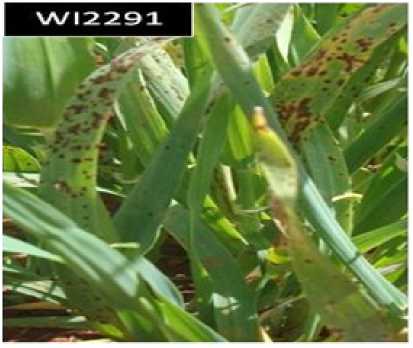
Unknown
Defense -related PR protein Transport Antifungal
Protease inhibitor Transcription МАРК related
R genes PR protein
Oxidative burst-related geenral
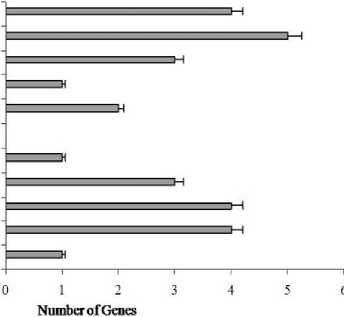
Figure 2. Transcripts expression grouped by functions in resistant barley cultivar infected with C. sativus (Jawhar et al. 2017).
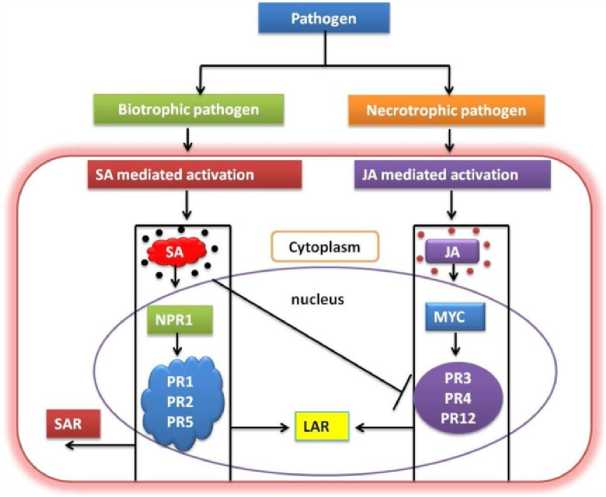
Figure . 3. An overview of activation of signaling cascades in plants after biotrophic and necrtrophic pathogenic infection (Ali et al., 2017).
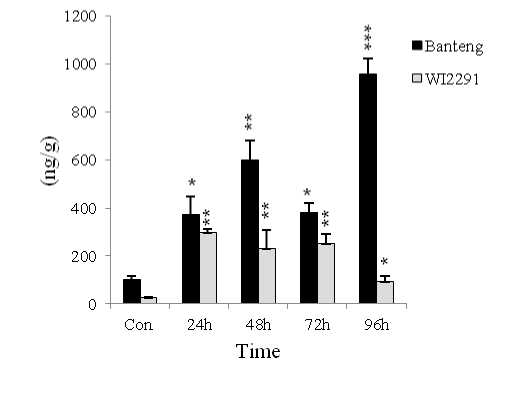
Figure 4. Quantification of total salicylic acid in barley leaves of resistant ‘Banteng’ and susceptible ‘WI2291’ cultivars 6 days post inoculation with C. sativus . Error bars are representative of the standard error (Mean ± SD, n = 3). Significance at * P < 0.05; ** P <0.01 and *** P < 0.001 within each genotype during different periods comparing with the control

Figure 5. Relative expression profiles of marker genes in the resistant genotype Banteng and in the susceptible genotype WI2291during the time course following infections with three diseases (Powdery mildew, net blotch and spot blotch). Error bars are representative of the standard error (Mean ± SD, n = 3). Data are normalized to Elongation factor 1α (EF-1α) gene expression level (to the calibrator, ontrol 0 h, taken as 0). (Al-Daoude et al., 2019).
CONCLUSION
This review summarizes the progress made to date in the research of barley- C. sativus interactions through PR alterations. Given the current availability of genomic and EST data, PR genes potentially involved in these interactions have been identified, and it is expected to provide the chance to raise their numbers in a near future, permitting subsequent works at the functional genomics level. However, although a better understanding of the barley resistance mechanisms has been achieved; hard work still lies ahead for the research society working on this resistance, regarding a deep lack of information on resistance genes at different levels from identification, function and regulation.
It would be attractive to study in more details about where and when different PRs are transcribed to better understand how barley plants utilize and coordinate their defense mechanisms towards C. sativus . Also, it would be valuable to know if the pure barley PRs have antifungal activity against C. sativus , separately or in various combinations and also in more detailed studies to see how this pathogen is affected. Since C. sativus secretes the toxin prehelminthosporol it would be of interest to see where it is recovered in the tissue, and if it affects the barley response in terms of localization and accumulation of different PRs .
ACKNOWLEDGMENTS
The authors thank the Director General of AE S and the Head of Molecular biology and Biotechnology Department for their support of this research.
CONFLICTS OF INTEREST
The authors declare that they have no potential conflicts of interest.
Список литературы Pathogenesis-related proteins dynamics during Cochliobolus sativus - barley interaction - an updated review
- AL-Daoude A, Jawhar M. 2009. Transcriptional changes in barley Cochliobolus sativus interaction. Australas. Plant Pathol. 38, 467–471.
- Al-Daoude A, Jawhar M, Arabi MIE. 2013. Hydrogen peroxide induction in barley-Cochliobolus sativus interaction. J. Plant Pathol. 95, 197-199.
- Al-Daoude A, Shoaib A, Al-Shehadah E, Jawhar M. 2017. Differential gene behavior in barley plants challenged with biotrophic and necrotrophic pathogens. Mycopath 15, 1-5.
- Al-Daoude A, Al-Shehadah E, Shoaib A, Jawhar M, Arabi MIE 2018. Salicylic acid and hydrogen peroxide accumulation in relation to hydrolyte leakage in barley plants challenged with Cochliobolus sativus. Cereal Res. Comm. 46, 1-8.
- Al-Daoude A, Al-Shehadah E, Shoaib A, Jawhar M, Arabi MIE 2019. Salicylic Acid pathway changes in barley plants challenged with either a biotrophic or a necrotrophic pathogen. Cereal Res. Comm. 47,1-8.
- Al-Daoude A, Jawhar M, Al-Shehadah E, Shoaib A, Moursel N, Arabi MIE. 2022. Changes in jasmonic and salicylic acids levels in barley challenged with Cochliobolus sativus. J. Stress Physiol. Biochem. 18, 40-46.
- Al-Sadi AM. 2021. Bipolaris sorokiniana-induced black point, common root rot and spot blotch diseases of wheat: A review. Front. Cell. Infect. Microbiol. 11, 584899.
- Ali S, Mir ZA, Bhat JA, Chandrashekar N, Papolu PK, Rawat S, Grover A. 2017. Identification and comparative analysis of Brassica juncea pathogenesis-related genes in response to hormonal, biotic and abiotic stresses. Acta Physiol. Plant. 39, 1–15.
- Ali S, Ganai BA, Kamili AN, Bhat AA, Mir ZA, Bhat JA, Grover A. 2018. Pathogenesis-related proteins and peptides as promising tools for engineering plants with multiple stress tolerance. Microbiol. Res. 212, 29–37.
- Ali Q, Yu C, Hussain A, Ali M, Ahmar S, Sohail MA, Riaz M, Ashraf MF, Abdalmegeed D, Wang X, Imran M, Manghwar H, Zhou L. 2022. Genome engineering technology for durable disease resistance: Recent progress and future outlooks for sustainable agriculture. Front. Plant Sci. 13, 860281.
- Alkan M, Bayraktar H, Imren M, Özdemir F Lahlali R, Mokrini F, Paulitz T, Dababat AA, Özer G. 2022. Monitoring of host suitability and defense-related genes in wheat to Bipolaris sorokiniana. J. Fungi 8, 149.
- Anisimova OK, Shchennikova AV, Kochieva EZ, Filyushin MA. 2021. Pathogenesis-Related Genes of PR1, PR2, PR4, and PR5 Families Are Involved in the Response to Fusarium Infection in Garlic (Allium sativum L.). Int J Mol Sci. 22, 6688.
- Antoniw JF, Ritter CE, Pierpoint WS, Van Loon LC. 1980. Comparison of three pathogenesis-related proteins from plants of two cultivars of tobacco infected with TMV. J. Gen. Virol. 47, 79 – 87.
- Arabi MIE, Jawhar M. 2004. Identification of Cochliobolus sativus (spot blotch) isolates expressing differential virulence on barley genotypes in Syria. J. Phytopathol. 152, 461-464.
- Arabi MIE, Al-Daoude A, Shoaib A, Jawhar M. 2015. Accumulation of Transcripts Abundance after Barley Inoculation with Cochliobolus sativus. The Plant Pathol. J. 72-77.
- Apoga D, Åkesson H, Jansson HB. et al. 2002. Relationship between production of the phytotoxin prehelminthosporol and virulence in isolates of the plant pathogenic fungus Bipolaris sorokiniana. Eur. J. Plant Pathol. 108, 519–526.
- Acharya K, Dutta AK, Pradhan P. 2011. Bipolaris sorokiniana (Sacc.) Shoem.: The most destructive wheat fungal pathogen in the warmer areas. Austr. J. Crop Sci. 5, 1064.
- Boccardo NA, Segretin ME, Hernandez I. et al. 2019. Expression of pathogenesis-related proteins in transplastomic tobacco plants confers resistance to filamentous pathogens under field trials. Sci Rep. 9, 2791.
- Capasso G, Santini G, Petraretti M, Esposito S, Landi S. 2021. Wild and traditional barley genomic resources as a tool for abiotic stress tolerance and biotic relations. Agri. 11, 1102.
- Castro-Camba R, Sánchez C, Vidal N, Vielba J.M. 2022. Interactions of gibberellins with phytohormones and their role in stress responses. Horticulturae 8, 241.
- Chen L, Yao Q, Wang F, Pang Y, Lang X, Sun D, Zhou J, Feng J, Lin R. 2022. Pathotype identification and virulence variation in Cochliobolus sativus in China. Plant Dis. 106, 2.
- Clark RV. 1979. Yield losses in barley cultivars caused by spot blotch. Can. J. Plant Pathol. 1, 113–117.
- Devi HM, Mahapatra S, Das S. 2018. Assessment of yield loss of wheat caused by spot blotch using regression model. Indian Phytopathol. 71, 291–294.
- Doke N, Miura Y, Sanchez LM, Park HJ, Toritake T, Yoshioka H, Kawakita K. 1996. The oxidative burst protects plants against pathogen attack: Mechanism and role as an emergency signal for plant bio-defense – a review. Gene 179, 45-51.
- Gadissa F, Abebe M, Bekele T. 2021. Agromorphological traits-based genetic diversity assessment in Ethiopian barley (Hordeum vulgare L.) landrace collections from Bale highlands, Southeast Ethiopia. Agric. Food Secur. 10, 58.
- GonzÁlez-Teuber M, Pozo MJ, Muck A, Svatos A, Adame-Álvarez RM, Heil M. 2010. Glucanases and chitinases as causal agents in the protection of Acacia extrafloral nectar from infestation by phytopathogens, Plant Physiol. 152, 1705–1715.
- Gupta PK, Chand R, Vasistha NK, Pandey SP, Kumar U, Mishra VK, Joshi AK. 2018. Spot blotch disease of wheat: The current status of research on genetics and breeding. Plant Pathol. 67, 508–531.
- Fang LJ, Qin RL, Liu Z, Liu CR, Ying-Ping Gai YP, Ling JIX 2019. Expression and functional analysis of a PR-1 Gene, MuPR1, involved in disease resistance response in mulberry (Morus multicaulis), J. Plant Interact. 14, 376-385.
- Hammond-Kosack KE, Jones JDG. 1996. Resistance gene dependent plant defense responses. Plant Cell 8, 1773-1791.
- Han X, Kahmann R. 2019. Manipulation of phytohormone pathways by effectors of filamentous plant pathogens. Front. Plant Sci. 10, 822.
- Hückelhoven R. 2007. Cell wall-associated mechanisms of disease resistance and susceptibility. Annu. Rev. Phytopathol. 45, 101-127.
- Jawhar M, Till BJ, Albaterni A, Skiheita A, Arabi MIE, Bakri Y, MirAli N. 2017a. Optimizing Ecotilling technique for tracking field Cochliobolus sativus population. J. Plant Pathol. 99, 339-345.
- Jawhar M, Shoiab A, Arabi MIE, Al-Daoude A. 2017b. Changes in transcript and protein expression levels in the barley — Cochliobolus sativus interaction. Cereal Res. Comm.45,1-10.
- Jeger M, Beresford R, Bock C. et al. 2021. Global challenges facing plant pathology: multidisciplinary approaches to meet the food security and environmental challenges in the mid-twenty-first century. CABI Agric Biosci 2, 20.
- Jo BR, Yu JM, Jang S, Ahn JW, Kim HS, Seoung EA, et al. 2020. Cloning, expression, and purification of a pathogenesis-related protein from Oenanthe javanica and its biological properties. Biol. Pharm. Bull. 43, 158–168.
- Juškyte AD, Mažeikiene I, Stanys V. 2022. Putative Genes of Pathogenesis-Related Proteins and Coronatine-Insensitive Protein 1 in Ribes spp. Plants 11, 355.
- Kaur PK, Joshi N, Singh IP, Saini HS. 2017. Identification of cyclic lipopeptides produced by Bacillus vallismortis R2 and their antifungal activity against Alternaria alternata. J. Appl. Microbiol. 122, 139–152.
- Kombrink E, Somssich IE. 1997. Pathogenesis-related proteins and plant defense, in Plant Relationships, eds Carroll G., Tudzynski P. (Berlin: Springer- Verlag).
- Kumar D, Chand R, Prasad LC, Joshi, AK. 2007. A new technique for monoconidial culture of the most aggressive isolate in a given population of Bipolaris sorokiniana, cause of foliar spot blotch in wheat and barley. World J. Microbiol. Biotechnol. 23, 1647–1651.
- Kumar S, Kumar N, Prajapati S, Maurya S. 2020. Review on spot blotch of wheat: An emerging threat to wheat basket in changing climate. J. Pharmacogn. Phytochem. 9, 1985–1997.
- Manandhar HK, Mathur SB, Smedegaard-Petersen V, Thordal-Christensen H. 1999. Accumulation of transcripts for pathogenesis-related proteins and peroxidase in rice plants triggered by Pyricularia oryzae, Bipolaris sorokiniana and UV light. Physiol. Mol. Plant Pathol. 55, 289– 295.
- Mauch F, Staehelin A. 1989. Functional implications of the subcellular localization of ethylene-induced chitinase and β -1,3-glucanase in bean leaves. The Plant Cell 1, 447-457.
- Mitsuhara I, Iwai T, Seo S, et al. 2008. Characteristic expression of twelve rice PR1 family genes in response to pathogen infection, wounding, and defense-related signal compounds (121/180). Mol Genet Genomics. 279, 415-427.
- Pieterse CMJ, Van-der Does D, Zamioudis C, Leon-Reyes A, Van Wees SCM. 2021. Hormonal modulation of plant immunity. Annu. Rev. Cell Dev. Biol. 28, 489-521.
- Popova EV, et al. 2017.The effect of salicylic acid and vanilline on wheat resistance to cochliobolus sativus. Mikologiya I Fitopatologiya 51,178-182
- Prasad R, Prasad LC, Chand R, Joshi AK. 2013. Assessment of diversity for resistance to spot blotch disease and its association with certain phenotypic traits in barley. Field Crops Res. 154, 195–200.
- Rebaque D, Del Hierro I, López G, Bacete L, Vilaplana F, Dallabernardina P, et al. 2021. Cell wall-derived mixed-linked β-1,3/1,4-glucans trigger immune responses and disease resistance in plants. Plant J. 106, 601–615.
- Rodríguez-Decuadro S, Silva P, Bentancur O, Gamba F, Pritsch C. 2014. Histochemical characterization of early response to Cochliobolus sativus infection in selected barley genotypes. Phytopathology 104, 715-723
- Rehman S, Gyawali S, Amri A, Verma RPS. 2020. First report of spot blotch of barley caused by Cochliobolus sativus in Morocco. Plant Dis. 104, 3.
- Santén K. 2007. Pathogenesis-related proteins in barley. Localization and accumulation patterns in response to infection by Bipolaris sorokiniana. Doctoral dissertation. ISSN 1652-6880.
- Schenk PM, Kazan K, Wilson I, Anderson JP, Richmond T, Somerville SC, Manners JM. 2000. Coordinated plant defense responses in Arabidopsis revealed by microarray analysis. PNAS. 97, 11655–11660.
- Shao D, Smith DL, Kabbage M, Roth MG. 2021. Effectors of plant necrotrophic fungi. Front. Plant Sci. 12, 687713.
- Sharma A, Sharma H, Rajput R, Pandey A, Upadhyay SK. 2022. Molecular characterization revealed the role of thaumatin-like proteins of bread wheat in stress response. Front. Plant Sci. 12, 807448.
- Stintzi A, Heitz T, Prasad V, Wiedemann-Merdinoglu S, Kauffmann S, Geoffroy P, Legrand M, Fritig B. 1993. Plant “pathogenesis-related” proteins and their role in defense against pathogens. Biochemie 75, 687-706.
- van Loon LC, Rep M, Pieterse CMJ. 2006. Significance of inducible defense related proteins in infected plants. Ann. Rev. Phytopathol. 44, 1-28.
- USDA 2022. World Barley Production 2021/2022. U.S. Department of Agriculture. 1400 Independence Ave., S.W. Washington, DC 20250 .
- Wisniewska H, Wakulinski W, Chelkowski J. 1998. Susceptibility of barleys to Bipolaris sorokiniana seedling blight determined by disease scoring and electrolyte leakage. J. Phytopath. 146, 563-566.
- Yousaf MJ, Hussain A, Hamayun M, Iqbal A, Lee IJ. 2022. Gibberellins hypersensitivity hinder the interaction of Bipolaris sorokiniana (Scc.) under cross talks with IAA and transzeatin. J. Plant Interact. 17, 152-167,
- Zhang W, et al. 2021. A novel effector, CsSp1, from Bipolaris sorokiniana, is essential for colonization in wheat and is also involved in triggering host immunity. Mol. Plant Pathol. 23, 218-236

